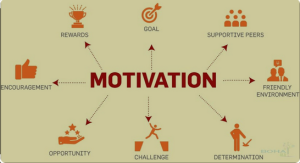Employee motivation plays a crucial role in influencing organizational productivity. Motivated employees are more likely to be engaged, committed, and productive, contributing positively to the overall success of the organization. Here are key ways in which employee motivation impacts organizational productivity:

Employee Motivation On Organizational Productivity
-
Table of Contents
ToggleIncreased Engagement:
- Motivated employees are more likely to be engaged in their work.
- Engaged employees are committed to their tasks, take initiative, and willingly invest time and effort in their roles, contributing to higher productivity.
-
Improved Job Performance:
- Motivated employees tend to exhibit higher levels of job performance.
- They are more likely to meet or exceed performance expectations, resulting in enhanced productivity across individual and team levels.
-
Higher Energy and Enthusiasm:
- Motivated employees bring higher levels of energy and enthusiasm to their work.
- Enthusiastic employees are more likely to tackle challenges with a positive attitude, leading to increased productivity and creativity.
-
Enhanced Problem-Solving and Innovation:
- Motivated employees are more likely to approach tasks with a problem-solving mindset.
- A motivated workforce is more innovative, generating creative ideas and solutions that contribute to improved processes and productivity.
-
Increased Job Satisfaction:
- Motivated employees are likely to experience higher job satisfaction.
- Satisfied employees tend to be more committed to their roles, leading to lower turnover rates and higher productivity due to a stable and experienced workforce.
-
Positive Organizational Culture:
- Employee motivation contributes to a positive organizational culture.
- A positive culture fosters collaboration, teamwork, and a sense of belonging, creating an environment where employees are motivated to contribute their best efforts.
-
Better Team Collaboration:
- Motivated employees are more likely to collaborate effectively with their colleagues.
- Team collaboration enhances productivity as employees work together cohesively, share ideas, and collectively contribute to achieving common goals.
-
Increased Employee Retention:
- Motivated employees are less likely to seek employment elsewhere.
- Lower turnover rates result in organizational stability, as retaining skilled and experienced employees contributes to sustained productivity.
-
Efficient Time Management:
- Motivated employees are more likely to manage their time efficiently.
- Effective time management results in the completion of tasks within deadlines, preventing delays and contributing to overall productivity.
-
Better Customer Service:
- Motivated employees are more likely to provide better customer service.
- Improved customer service enhances the overall customer experience, which can positively impact the organization’s reputation and long-term productivity.
-
Alignment with Organizational Goals:
- Motivated employees are more likely to align with organizational goals and objectives.
- A shared vision and goal alignment contribute to focused efforts and coordinated actions that drive organizational productivity.
-
Recognition and Reward Systems:
- Motivated employees respond positively to recognition and rewards.
- Recognition programs and rewards create a culture of appreciation, motivating employees to consistently perform at their best and contribute to productivity.
In conclusion, employee motivation is a powerful driver of organizational productivity. Organizations that prioritize creating a motivational work environment, fostering employee engagement, and recognizing individual contributions are more likely to experience sustained productivity and success in the long term.
